elasticsearch基础及在Python中的简单使用
一. 安装java环境与elasticsearch、kibana
首先要求jdk为1.8及以上,这里elasticsearch(kibana同理,尽量保证elasticsearch版本一致,安装和启动方式也是一样的)版本采用6.5.4。
elasticsearch简介:https://baike.baidu.com/item/elasticsearch/3411206?fr=aladdin
elasticsearch官网:https://www.elastic.co/cn/downloads/

点击下载,之后下拉选择历史版本past releases
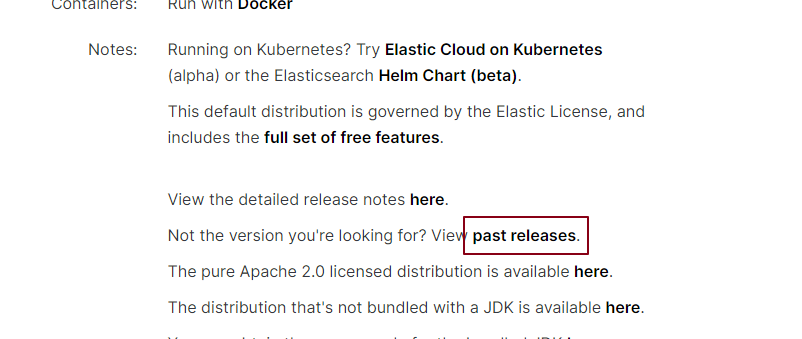
最后点击download即可

java环境配置看该博客:https://www.cnblogs.com/Neeo/articles/10368280.html
安装完毕后如果没有出现错误,解压elasticsearch,然后进入其bin目录,双击打开其中的elasticsearch.bat文件即可,随后访问127.0.0.1:9200,如果能看到返回的json数据,代表配置成功。(其中9200是节点监听的断开,而9300是集群默认监听的端口)。
未能正常启动原因

二. elasticsearch、kibana的部分文件说明
1. 解压后的config中的elasticsearch.yml就是ES的配置文件,这用Notepad打开。




同目录的jvm.options是虚拟机jrel的配置。

同目录的log4j2.properties是日志的配置,可以配置日志的输出、级别等信息,一般不会修改。(log4j是Apache的一个框架,用于控制日志)
- Kibana目录下的config中的kibana.yml存放其配置文件。



三. Kibana的Dev tools中ES的简单命令
数据准备
PUT s18/doc/2{"name":"yangtao","age": 18,"tags":"浪","b":"19970521","sex": "男"}PUT s18/doc/1{"name":"egon","age": 20,"tags":"认真学习","b":"19970781","sex": "男"}PUT s18/doc/3{"name":"sybil","age": 3,"tags":"认真学习","b":"19971216","sex": "女"}
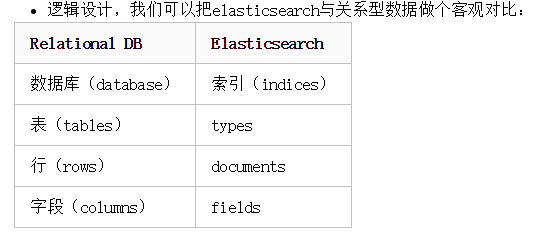
以 '索引/类型/文档' 的格式#增 PUT 如果PUT对的数据已存在,那么会进行更新的操作,但是PUT时传的参数是什么,更新之后的数据就是什么,所以需要填写所有的字段PUT s18/doc/1 #新增索引s18/doc/1 s18是_index,1是该数据的文档,doc是Type{"name":"sybil","skill":"fly","hobby":"sleep","tags":"beautiful"}#删 DELETEDELETE s18 #删除索引(数据库)DELETE s18/doc/1 #删除索引s18下type是doc,文档是1的数据DELETE s18/doc/_search?q=tags:beautiful #这是错误的删除方式,要使用search的方式删除需要使用POST#查 GETGET s18/doc/1 #查文档为1的数据GET s18/doc/_search #查所有GET s18/doc/_search?q=name:sybil #查名字叫sybil的#更新指定字段POST,或配合search删除POST s18/doc/1/_update{"doc":{ # 需要指定type,相当于指定表名"tags":"美丽冻人"}}POST s18/doc/_delete_by_query?q=age:18 #删除年龄为18的数据,不过不推荐使用该方式#查询的两种方式1.查询字符串 query stringGET s18/doc/_search?q=age:182. DSL 结构化查询GET s18/doc/_search{"query":{"match":{"age":18}}}GET s18/doc/_search{"query":{"match_all":{} #因为是查所有,不需要参数}}
- GET s18/_mapping
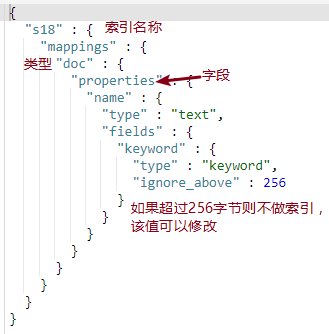
GET s18/_settings

GET s18
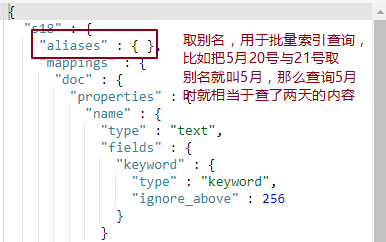
四. ES的复杂查询
1.排序sort、分页、布尔查询bool
#排序 sort 不是所有的字段都能排序,比如名字GET s18/doc/_search{"query":{"match_all":{}},"sort": [ #排序{"age":{"order": "asc" #升序,desc降序}}]}#分页 内部会先排好序,保证翻页后不会出现已经返回过的数据GET s18/doc/_search{"query":{"match_all":{}},"from": 0, #从0条开始"size": 2 #返回2条数据}#布尔查询bool: should(or) must(and) must_not(not),must_notGET s18/doc/_search{"query": {"bool": {"should": [ #名字是sybil或者年龄18岁{"match": {"name": "sybil"}},{"match": {"age": "18"}}]}}}'查询性别是男的,年龄18'GET s18/doc/_search{"query": {"bool":{"must": [{"match": {"age": "18"}},{"match": {"sex": "男"}}]}}}#查询年龄大于19岁的男的 filter尽量用must配合,避免脏数据GET s18/doc/_search{"query": {"bool": {"must": [{"match": {"sex": "男"}}],"filter": {"range": {"age": {"gte": 19,"lte": 20}}}}}}
2.高亮查询highlight
#查询name是sybil的文档#高亮查询,查询name是sybil的文档,查询的结果需要在前端才能体现高亮,因为是标签的效果GET s18/doc/_search{"query": {"match": {"name": "sybil"}},"highlight": {"fields": {"name": {} #查询的结果用<em>标签包裹}}}GET s18/doc/_search{"query": {"match": {"name": "sybil" #会将我们这里定义的字段高亮显示}},"highlight": { #可以使用pre_tags与post_tags自定义标签"pre_tags": "<b style='color:red;font-size:20px'>","post_tags": "<\b>","fields": {"name": {} #这里指定字段后空着即可}}}
3.结果过滤_source
#过滤出查询结果中想要的字段GET s18/doc/_search{"query": {"match": {"name": "sybil"}},"_source": "name" #单个字段}GET s18/doc/_search{"query": {"match": {"name": "sybil"}},"_source": ["name", "age"] #多个字段}
4.聚合查询
#sum,查询所有男生的年龄GET s18/doc/_search{"query": {"match": {"sex": "男"}},"aggs": {"my_sum": { #这是查询结果的键,可以自定义"sum": { #这是聚合的方法"field": "age" #指定聚合的依据}}}}#查询最大年龄的男生GET s18/doc/_search{"query": {"match": {"sex": "男"}},"aggs": {"my_max": {"max": {"field": "age"}}}}#查询最小年龄的男生GET s18/doc/_search{"query": {"match": {"sex": "男"}},"aggs": {"my_min": {"min": {"field": "age"}}}}#查询男生的平均年龄GET s18/doc/_search{"query": {"match": {"sex": "男"}},"aggs": {"my_avg": {"avg": {"field": "age"}}}}#分组,根据年龄,0-10,,0-20GET s18/doc/_search{"query": {"match": {"sex": "男"}},"aggs": {"my_group": { #分组名称"range": {"field": "age","ranges": [{"from": 0, #[0, 10)"to": 10},{"from": 10,"to": 20},{"from": 20,"to": 30}]}}}}#分组,根据年龄,0-10,,0-20, 对每组年龄求和GET s18/doc/_search{"query": {"match": {"sex": "男"}},"aggs": {"my_group": {"range": {"field": "age","ranges": [{"from": 0,"to": 10},{"from": 10,"to": 20},{"from": 20,"to": 30}]},"aggs": {"my_sum": {"sum": {"field": "age"}}}}}}
5. ES的mapping映射
#自定义索引的映射PUT s2{"mappings": {"doc":{ #类型"properties":{ #文档的属性"name":{"type":"text"},"age":{"type":"long"},"desc":{"type":"text"}}}}}#如果给该索引加文档时,额外增加了字段,那么mappings会自动增加该字段,使其能够成为查询条件GET s2/_mappingPUT s2/doc/2{"name":"catmao","age":30,"desc":"beautiful","skill":"sleep"}GET s2/_mapping #再次执行会发现字段多了skill#这是由mappings的dynamic的三种状态,三种状态时,均可以缺省字段dynamic为true时特征如上。dynamic为false时,PUT添加的数据有额外字段时,Mapping不会自动添加,该字段也无法成为查询的条件。dynamic为strict时,添加的数据不能有额外的字段,会直接报错PUT s6{"mappings": {"doc":{"dynamic":"strict","properties":{"name":{"type":"text"}}}}}#mapping的ignore_above,不会为超过该设定字符长度的字符串设定索引与存储,即无法成为有效的查询条件,仅对type为keyword的字段有效。https://www.cnblogs.com/Neeo/articles/10789701.htmlPUT s7{"mappings": {"doc":{"properties":{"title":{"type":"keyword","ignore_above":10}}}}}PUT s7/doc/2{"title":"从手机、平板电脑、路由器"}PUT s7/doc/1{"title":"1234567"}GET s7/doc/_search{"query": {"match": {"title": "1234567"}}}#mappings参数之index,设置为false后,ES不会为该字段建立索引,其实是不会做分词#mappings的index参数PUT s8{"mappings": {"doc":{"properties":{"t1":{"type":"text","index":"true"},"t2":{"type":"text","index":"false"}}}}}PUT s8/doc/1{"t1":"论母猪的厂前保养","t2":"论母猪的厂后保养"}GET s8/doc/_search{"query": {"match": {"t2": "母猪"}}}#mappings的copy_to,把一个字段的值复制给另一个,可以减少一次查询的次数PUT s9{"mappings": {"doc":{"properties":{"t1":{"type":"text","copy_to":"full_name" #复制给多个字段 ["f1", "f2"]},"t2":{"type":"text","copy_to":"full_name"},"full_name":{"type":"text"}}}}}PUT s9/doc/1{"t1":"xxx","t2":"ooo"}GET s9/doc/_search{"query": {"match": {"full_name": "xxx"}}}
6.嵌套属性
#嵌套类型PUT w1{"mappings": {"doc":{"properties":{"name":{"type":"text"},"age":{"type":"long"},"info":{ #info字段嵌套两个字段"properties":{"addr":{"type":"text"},"tel":{"type":"long"}}}}}}}PUT w1/doc/1 #插入一条数据{"name":"tom","age":18,"info":{"addr":"北京","tel":"10010"}}GET w1/doc/_search{"query": {"match": {"info.tel": "10010" #以嵌套字段的属性为查询条件时,直接点语法即可}}}
7.settings设置主从分片
#主分片一旦设置无法更改,复制分片可以PUT w2{"mappings": {"doc":{"properties":{"title":{"type":"text"}}}},"settings": { #通过settings设置"number_of_shards": 3, #主分片数量,默认为5"number_of_replicas": 3 #复制分片数量,默认为1}}GET w2
8.match系列

博客地址https://www.cnblogs.com/Neeo/articles/10578482.html
#数据准备PUT t1/doc/1{"title":"中国是世界上人口最多的国家"}PUT t1/doc/2{"title":"美国是世界上军事实力强大多的国家"}PUT t1/doc/3{"title":"北京是中国 的首都"}
使用match查询“中国”
#会发现美国也包含在其中,这是因为match内部会散列分词,内部是采用标准的分析器,中国会分为中和国GET t1/doc/_search{"query": {"match": {"title": "中国"}}}
我们想把中国当成一个短语,需要采用match_phrase
#这样就不好分词,把中国当成一个短语去查询GET t1/doc/_search{"query": {"match_phrase": {"title": "中国""slop": 1 #该参数可以指定分词的间隔}}}
最左前缀查询match_phrase_prefix
PUT t2/doc/1{"title":"beautiful girl"}PUT t2/doc/2{"title":"beautiful so"}GET t2/doc/_search{"query": {"match_phrase_prefix": {"title": "bea" #只要有单词以bea开头}}}
multi_match多字段查询,可以完成match_phrase和match_phrase_prefix的工作,使用很灵活。
PUT t3/doc/1{"t1":"beautiful girl","t2":"beautiful so"}#查找字段t1和t2都包含beautiful的文档GET t3/doc/_search{"query": {"multi_match": {"query": "beautiful","fields": ["t1", "t2"]}}}
五. elasticsearch分析数据的过程漫谈
详见博客https://www.cnblogs.com/Neeo/p/10304892.html,附带安装ik分词
5.1 ik安装的问题
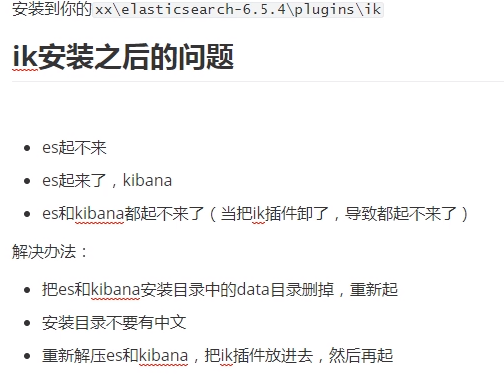
5.2 ik分词的测试
#ik分词的测试GET _analyze{"analyzer": "standard","text":"上海自来水来自海上"}GET _analyze{"analyzer": "ik_smart","text":"上海自来水来自海上"}#粒度更细,一般存储时建议使用粒度粗的(意义更大),ik_max_word会将文档做最细粒度的拆分GET _analyze{"analyzer": "ik_max_word","text":"上海自来水来自海上"}
六. python操作Elasticsearch
6.1 python连接 ES
doc_type默认是doc,所以可以不写,不过建议都写上,以防万一
'1. 安装elasticsearch模块'pip install elasticsearch# 豆瓣源pip install -i https://pypi.doubanio.com/simple/ elasticsearch'2. 连接的方式'from elasticsearch import Elasticsearch# es = Elasticsearch() # 默认连接本地elasticsearch# es = Elasticsearch(['127.0.0.1:9200']) # 连接本地9200端口es = Elasticsearch(["192.168.1.10", "192.168.1.11", "192.168.1.12"], # 连接集群,以列表的形式存放各节点的IP地址sniff_on_start=True, # 连接前测试sniff_on_connection_fail=True, # 节点无响应时刷新节点sniff_timeout=60 # 设置超时时间)'3. 配置忽略响应状态码'es = Elasticsearch(['127.0.0.1:9200'],ignore=400) # 忽略返回的400状态码es = Elasticsearch(['127.0.0.1:9200'],ignore=[400, 405, 502]) # 以列表的形式忽略多个状态码'4. 简单的示例'from elasticsearch import Elasticsearches = Elasticsearch() # 默认连接本地elasticsearch# print(es.ping()) #可以用该方法查看是否连接成功,如果群集已启动,则返回True,否则返回Falseprint(es.index(index='p1', doc_type='doc', id=1, body={'name': "sybil", "age": 18})) #index方法,如果索引存在则更新,否则增加新记录print(es.get(index='p1', doc_type='doc', id=1))
6.2 python操作ES
# search方法使用的较多,因为可以跟复杂查询'对返回的信息的几种过滤方法(过滤出想要显示的信息)'body = {"query": {"match": {"name": "lou22"}}}# 返回的是一个大字典print(es.search(index='p1', body=body))# 可以使用filter_path过滤出其中想要的信息print(es.search(index='p1', body=body, filter_path=['hits.hits']))# 查询出来的信息主要保存在_source中 {'hits': {'hits': [{'_source': {'name': 'lou22'}}]}}print(es.search(index='p1', body=body, filter_path=['hits.hits._source']))# 也可以指定多个要显示的信息 {'hits': {'total': 1, 'hits': [{'_source': {'name': 'lou22'}}]}}print(es.search(index='p1', body=body, filter_path=['hits.hits._source', 'hits.total']))# 可以用*指定返回hits下所有的内容 *是语法,表示所有print(es.search(index='p1', body=body, filter_path=['hits.*']))# 可以用*指定返回hits下的hits中所有的内容print(es.search(index='p1', body=body, filter_path=['hits.hits._*']))'过滤出结果中想要的字段,_source'print(es.search(index='py3', doc_type='doc', body={"query": {"match":{"age": 20}}})) # 一般查询print(es.search(index='py3', doc_type='doc', body={"query": {"match":{"age": 19}}},_source=['name', 'age'])) # 结果字段过滤print(es.search(index='py3', doc_type='doc', body={"query": {"match":{"age": 19}}},_source_exclude =[ 'age'])) #除了age字段之外的所有字段都要print(es.search(index='py3', doc_type='doc', body={"query": {"match":{"age": 19}}},_source_include =[ 'age'])) #只要age字段,同_source差不多
get_source直接返回数据字典
# 直接返回数据字典 {'name': 'lou22'}print(es.get_source(index='p1', doc_type='doc', id=1))
count统计查询结果的个数
# 新建几条数据for i in range(2, 11):print(es.index(index='p1', doc_type='doc', body={"name": "lou%s" % i}))# 指定用于查询的方式body = {"query": {"match": {"name": "lou2"}}}#查询回来的结果就是字典,可以采用字典的操作方式print(es.count(index='p1', doc_type='doc', body=body))['count'] # 1print(es.count(index='w2')) # {'count': 6, '_shards': {'total': 5, 'successful': 5, 'skipped': 0, 'failed': 0}}print(es.count(index='w2', doc_type='doc')) # {'count': 6, '_shards': {'total': 5, 'successful': 5, 'skipped': 0, 'failed': 0}}
es.create****创建索引(索引不存在的话)并新增一条数据,索引存在仅新增(只能新增,重复执行会报错
#其实内部调用了es.index,一般不使用create方法print(es.create(index='py3', doc_type='doc', id='1', body={"name": '王五', "age": 20}))print(es.get(index='py3', doc_type='doc', id='1'))
es.delete与es.delete_by_query
#es.delete,删除指定的文档。比如删除文章id为4的文档,但不能删除索引,如果想要删除索引,还需要es.indices.delete来处理print(es.delete(index='py3', doc_type='doc', id='4'))#es.delete_by_query,删除与查询匹配的所有文档print(es.delete_by_query(index='py3', doc_type='doc', body={"query": {"match":{"age": 20}}}))
es.exists与es.info
# es.exists,查询elasticsearch中是否存在指定的文档,返回一个布尔值print(es.exists(index='py3', doc_type='doc', id='1'))#es.info,获取当前集群的基本信息,一般使用kibana查看,因为比较直观print(es.info())
6.3 es.indices对索引的操作
es.indices.create****在Elasticsearch中创建索引,用的最多
body = {"mappings": {"doc": {"dynamic": "strict", #设置严格模式"properties": {"title": {"type": "text","analyzer": "ik_max_word"},"url": {"type": "text"},"action_type": {"type": "text"},"content": {"type": "text"}}}}}es.indices.create('py4', body=body)
es.indices.analyze,返回分词结果
es.indices.analyze(body={'analyzer': "ik_max_word", "text": "皮特和茱丽当选“年度模范情侣”Brad Pitt and Angelina Jolie"})
es.indices.delete,在Elasticsearch中删除索引
print(es.indices.delete(index='py4'))print(es.indices.delete(index='w3')) # {'acknowledged': True}
es.indices.put_alias,为一个或多个索引创建别名,查询多个索引的时候,可以使用这个别名
print(es.indices.put_alias(index='py4', name='py4_alias')) # 为单个索引创建别名print(es.indices.put_alias(index=['py3', 'py2'], name='py23_alias')) # 为多个索引创建同一个别名,联查用
es.indices.delete_alias,删除一个或多个别名
print(es.indices.delete_alias(index='alias1'))print(es.indices.delete_alias(index=['alias1, alias2']))
es.indices.get_mapping,检索索引或索引/类型的映射定义
print(es.indices.get_mapping(index='py4'))
es.indices.get_settings,检索一个或多个(或所有)索引的设置
print(es.indices.get_settings(index='py4'))
es.indices.get,允许检索有关一个或多个索引的信息
print(es.indices.get(index='py2')) # 查询指定索引是否存在print(es.indices.get(index=['py2', 'py3']))
es.indices.get_alias,检索一个或多个别名
print(es.indices.get_alias(index='py2'))print(es.indices.get_alias(index=['py2', 'py3']))
es.indices.get_field_mapping,检索特定字段的映射信息
print(es.indices.get_field_mapping(fields='url', index='py4', doc_type='doc'))print(es.indices.get_field_mapping(fields=['url', 'title'], index='py4', doc_type='doc'))
其他
# es.indices.delete_alias,删除特定别名。# es.indices.exists,返回一个布尔值,指示给定的索引是否存在。# es.indices.exists_type,检查索引/索引中是否存在类型/类型。# es.indices.flus,明确的刷新一个或多个索引。# es.indices.get_field_mapping,检索特定字段的映射。# es.indices.get_template,按名称检索索引模板。# es.indices.open,打开一个封闭的索引以使其可用于搜索。# es.indices.close,关闭索引以从群集中删除它的开销。封闭索引被阻 止进行读/写操作。# es.indices.clear_cache,清除与一个或多个索引关联的所有缓存或特定缓存。# es.indices.put_alias,为特定索引/索引创建别名。# es.indices.get_uprade,监控一个或多个索引的升级程度。# es.indices.put_mapping,注册特定类型的特定映射定义。# es.indices.put_settings,实时更改特定索引级别设置。# es.indices.put_template,创建一个索引模板,该模板将自动应用于创建的新索引。# es.indices.rollove,当现有索引被认为太大或太旧时,翻转索引API将别名转移到新索引。API接受单个别名和条件列表。别名必须仅指向单个索引。如果索引满足指定条件,则创建新索引并切换别名以指向新别名。# es.indices.segments,提供构建Lucene索引(分片级别)的低级别段信息
6.4 Cluster 集群相关
es.cluster.get_settigns,获取集群设置
print(es.cluster.get_settings())
es.cluster.health,获取有关群集运行状况的非常简单的状态
print(es.cluster.health())
es.cluster.state,获取整个集群的综合状态信息
print(es.cluster.state())
es.cluster.stats,返回群集的当前节点的信息
print(es.cluster.stats())
6.5 Node 节点相关
es.nodes.info,返回集群中节点的信息
print(es.nodes.info()) # 返回所节点print(es.nodes.info(node_id='node1')) # 指定一个节点print(es.nodes.info(node_id=['node1', 'node2'])) # 指定多个节点列表
es.nodes.stats,获取集群中节点统计信息
print(es.nodes.stats())print(es.nodes.stats(node_id='node1'))print(es.nodes.stats(node_id=['node1', 'node2']))
es.nodes.hot_threads,获取指定节点的线程信息
print(es.nodes.hot_threads(node_id='node1'))print(es.nodes.hot_threads(node_id=['node1', 'node2']))
es.nodes.usage,获取集群中节点的功能使用信息
print(es.nodes.usage())print(es.nodes.usage(node_id='node1'))print(es.nodes.usage(node_id=['node1', 'node2']))
6.6 Cat 一种查询方式
es.cat.aliases,返回别名信息
#name要返回的以逗号分隔的别名列表。#formatAccept标头的简短版本,例如json,yamlprint(es.cat.aliases(name='py23_alias'))print(es.cat.aliases(name='py23_alias', format='json'))
es.cat.allocation,返回分片使用情况
print(es.cat.allocation())print(es.cat.allocation(node_id=['node1']))print(es.cat.allocation(node_id=['node1', 'node2'], format='json'))
es.cat.count,Count提供对整个群集或单个索引的文档计数的快速访问
print(es.cat.count()) # 集群内的文档总数print(es.cat.count(index='py3')) # 指定索引文档总数print(es.cat.count(index=['py3', 'py2'], format='json')) # 返回两个索引文档和
es.cat.fielddata,基于每个节点显示有关当前加载的fielddata的信息。有些数据为了查询效率,会放在内存中,fielddata用来控制哪些数据应该被放在内存中,而这个es.cat.fielddata则查询现在哪些数据在内存中,数据大小等信息
print(es.cat.fielddata())print(es.cat.fielddata(format='json', bytes='b'))#bytes显示字节值的单位,有效选项为:'b','k','kb','m','mb','g','gb','t','tb' ,'p','pb'#formatAccept标头的简短版本,例如json,yaml
es.cat.health,从集群中health里面过滤出简洁的集群健康信息
print(es.cat.health())print(es.cat.health(format='json'))
es.cat.help,返回es.cat的帮助信息
print(es.cat.help())
es.cat.indices,返回索引的信息
print(es.cat.indices())print(es.cat.indices(index='py3'))print(es.cat.indices(index='py3', format='json'))
es.cat.master,返回集群中主节点的IP,绑定IP和节点名称
print(es.cat.master())print(es.cat.master(format='json'))
es.cat.nodeattrs,返回节点的自定义属性
print(es.cat.nodeattrs())print(es.cat.nodeattrs(format='json'))
es.cat.nodes,返回节点的拓扑,这些信息在查看整个集群时通常很有用,特别是大型集群。我有多少符合条件的节点
print(es.cat.nodes())print(es.cat.nodes(format='json'))
es.cat.plugins,返回节点的插件信息
print(es.cat.plugins())print(es.cat.plugins(format='json'))
es.cat.segments,返回每个索引的Lucene有关的信息
print(es.cat.segments())print(es.cat.segments(index='py3'))print(es.cat.segments(index='py3', format='json'))
es.cat.shards,返回哪个节点包含哪些分片的信息
print(es.cat.shards())print(es.cat.shards(index='py3'))print(es.cat.shards(index='py3', format='json'))
es.cat.thread_pool,获取有关线程池的信息
print(es.cat.thread_pool())
6.7 Snapshot 快照相关
# es.snapshot.create,在存储库中创建快照。repository 存储库名称。snapshot快照名称。body快照定义。# es.snapshot.delete,从存储库中删除快照。# es.snapshot.create_repository。注册共享文件系统存储库。# es.snapshot.delete_repository,删除共享文件系统存储库。# es.snapshot.get,检索有关快照的信息。# es.snapshot.get_repository,返回有关已注册存储库的信息。# es.snapshot.restore,恢复快照。# es.snapshot.status,返回有关所有当前运行快照的信息。通过指定存储库名称,可以将结果限制为特定存储库。# es.snapshot.verify_repository,返回成功验证存储库的节点列表,如果验证过程失败,则返回错误消息
6.8 Task 任务相关
# es.tasks.get,检索特定任务的信息。# es.tasks.cancel,取消任务。# es.tasks.list,任务列表
七. python使用ES搜索小例子
7.1 settings.py中指定连接数据库
DATABASES = {'default': {'ENGINE': 'django.db.backends.mysql','NAME': 'test_es','HOST': '127.0.0.1','PORT': 3306,'USER': 'root','PASSWORD': 'root'}}
7.2 models.py中建立模型表,并同步至数据库
from django.db import modelsclass Car(models.Model):title = models.CharField(max_length=255)summary = models.CharField(max_length=255)img_url = models.CharField(max_length=255, null=True)tags = models.CharField(max_length=255)a_url = models.CharField(max_length=255)
随后执行数据库迁移命令
python manage.py makemigrationspython manage.py migrate
7.3 新建一个spider.py文件,配置django环境,爬取数据
#!/usr/bin/env pythonimport osif __name__ == "__main__":os.environ.setdefault("DJANGO_SETTINGS_MODULE", "review_django.settings")import djangodjango.setup()import requestsfrom bs4 import BeautifulSoupfrom concurrent.futures import ThreadPoolExecutorfrom app01 import modelsdef work(k):response = requests.get(url='https://www.autohome.com.cn/all/{}/#liststart'.format(k))response.encoding = 'GBK'soup_obj = BeautifulSoup(response.text, 'html.parser')div_obj = soup_obj.find(name='div', attrs={"id": "auto-channel-lazyload-article"})li_list = div_obj.find_all(name='li')for i in li_list:no_obj = i.find(name='h3')if not no_obj: continuetitle = i.find(name='h3').textsummary = i.find(name='p').texta = 'https:' + i.find(name='a').get('href')img = 'https:' + i.find(name='img').get('src')tags = a.split('/', 4)[3]print(response.url, title, tags)print(summary, img)models.Car.objects.create(title=title,summary=summary,tags=tags,img_url=img,a_url=a)def spider():t = ThreadPoolExecutor(10)for k in range(1, 60):t.submit(work, k)t.shutdown()spider()
7.4 urls.py中配置路由
from django.conf.urls import urlfrom app01 import viewsurlpatterns = [# 用于简单显示一个页面,同时展示用户搜索的内容url(r'index', views.index),# 将数据库数据写入esurl(r'es', views.es2)]
7.5 views.py中视图函数
from django.shortcuts import render, HttpResponsefrom django.http import JsonResponsefrom elasticsearch import Elasticsearchfrom elasticsearch import helpersfrom app01 import models# 实例化一个ES对象es = Elasticsearch()# Create your views here.def filter(search_msg):body = {"size": 100, # 返回一百条数据"query": {"match": {"title": search_msg # 从标题中查找输入的关键字}},"highlight": { # 内容高亮显示,使用pre_tags与post_tags定义标签,默认是em标签"pre_tags": "<b style='color:red;font-size:24px'>","post_tags": "</b>","fields": {"title": {} # 将标题高亮显示}},}# 存储es搜索的结果res = es.search(index='s18', body=body)# print(res)return resdef index(request):if request.method == "POST":search_msg = request.POST.get('search_msg')res = filter(search_msg)# 将es搜索的结果返回return JsonResponse(res)return render(request, 'search.html', locals())def es2(request):body = {"mappings": {"doc": {"properties": {"title": {"type": "text"},"summary": {"type": "text"},"a_url": {"type": "keyword"},"img_url": {"type": "keyword"},"tags": {"type": "text"}}}}}# es.indices.create(index='s18', body=body)# print(es.indices.get_mapping())query_list = models.Car.objects.all()# 定义写入es的数据格式,使用生成器,减轻内存压力action = ({"_index": "s18", # 索引,相当于指定数据库,不存在则创建"_type": "doc", # 类型,相当于指定表,不存在则创建"_source": { # 指定要写入的内容"title": i.title,"summary": i.summary,"a_url": i.a_url,"img_url": i.img_url,"tags": i.tags}}for i in query_list)# helpers会使用java虚拟机帮我们进行该任务helpers.bulk(es, action)return HttpResponse('ok es')
7.6 templates文件下写的search.html
<!DOCTYPE html><html lang="en"><head><meta charset="UTF-8"><title>Title</title><script src="https://cdn.bootcss.com/jquery/3.4.1/jquery.min.js"></script><script src="https://cdn.bootcss.com/twitter-bootstrap/3.4.1/js/bootstrap.min.js"></script><link href="https://cdn.bootcss.com/twitter-bootstrap/3.4.1/css/bootstrap.min.css" rel="stylesheet"></head><body><nav class="navbar navbar-default"><div class="container-fluid"><!-- Brand and toggle get grouped for better mobile display --><div class="navbar-header"><button type="button" class="navbar-toggle collapsed" data-toggle="collapse" data-target="#bs-example-navbar-collapse-1" aria-expanded="false"><span class="sr-only">Toggle navigation</span><span class="icon-bar"></span><span class="icon-bar"></span><span class="icon-bar"></span></button><a class="navbar-brand" href="#">Brand</a></div><!-- Collect the nav links, forms, and other content for toggling --><div class="collapse navbar-collapse" id="bs-example-navbar-collapse-1"><ul class="nav navbar-nav"><li class="active"><a href="#">Link <span class="sr-only">(current)</span></a></li><li><a href="#">Link</a></li><li class="dropdown"><a href="#" class="dropdown-toggle" data-toggle="dropdown" role="button" aria-haspopup="true" aria-expanded="false">Dropdown <span class="caret"></span></a><ul class="dropdown-menu"><li><a href="#">Action</a></li><li><a href="#">Another action</a></li><li><a href="#">Something else here</a></li><li role="separator" class="divider"></li><li><a href="#">Separated link</a></li><li role="separator" class="divider"></li><li><a href="#">One more separated link</a></li></ul></li></ul>{# 搜索框 #}<form class="navbar-form navbar-left"><div class="form-group"><input type="text" class="form-control" placeholder="Search" oninput="foo()" id="search"></div><button type="submit" class="btn btn-default">Submit</button><span id="totalNum"></span></form><ul class="nav navbar-nav navbar-right"><li><a href="#">Link</a></li><li class="dropdown"><a href="#" class="dropdown-toggle" data-toggle="dropdown" role="button" aria-haspopup="true" aria-expanded="false">Dropdown <span class="caret"></span></a><ul class="dropdown-menu"><li><a href="#">Action</a></li><li><a href="#">Another action</a></li><li><a href="#">Something else here</a></li><li role="separator" class="divider"></li><li><a href="#">Separated link</a></li></ul></li></ul></div><!-- /.navbar-collapse --></div><!-- /.container-fluid --><div class="container"><div class="row"><div class="col-md-8 col-lg-offset-2"><div id="showData"></div></div></div></div></nav></body><script>//搜索function foo() {var searchMsg = $('#search').val();console.log(searchMsg);$.ajax({url:"/app01/index",type: "post",data: {'search_msg': searchMsg},success:function (data) {console.log(data);if (data){//展示结果条数$("#totalNum").html("结果约<b style='color:red'>" + data.hits.total + "<b>")//结果展示var html = '';$.each(data.hits.hits, function (index, item) {//console.log(item._source.title)html += "<a href='+ item.a_url +'>\n" +" <div class=\"article-pic\"></div>\n" +" <h3>"+item.highlight.title+"</h3>\n" +" <div class=\"article-bar\">\n" +" <span class=\"fn-left\"></span>\n" +" <span class=\"fn-right\">\n" +" <em><i class=\"icon12 icon12-eye\"></i></em>\n" +" <em data-class=\"icon12 icon12-infor\" data-articleid=\"945066\"><i class=\"icon12 icon12-infor\"></i>13</em>\n" +" </span>\n" +" </div>\n" +" <p>"+item._source.summary+"</p>\n" +" </a>";$("#showData").html(html)})}}})}</script></html>
7.7 启动项目先访问es路由,后面访问index即可
elasticsearch基础及在Python中的简单使用的更多相关文章
- python基础系列教程——Python中的编码问题,中文乱码问题
python基础系列教程——Python中的编码问题,中文乱码问题 如果不声明编码,则中文会报错,即使是注释也会报错. # -*- coding: UTF-8 -*- 或者 #coding=utf-8 ...
- python中一个简单的webserver
python中一个简单的webserver 2013-02-24 15:37:49 分类: Python/Ruby 支持多线程的webserver 1 2 3 4 5 6 7 8 9 10 11 ...
- Python 中lambda 简单介绍
转自:https://www.cnblogs.com/AlwaysWIN/p/6202320.html 在学习python的过程中,lambda的语法经常出现,现在将它整理一下,以备日后查看. 1.l ...
- 『无为则无心』Python基础 — 8、Python中的数据类型(数值、布尔、字符串)
目录 1.数据类型介绍 2.数值型(Number) 3.布尔型(bool) 4.None(空值) 5.常量 6.字符串(String) 1.数据类型介绍 (1)什么是数据类型 在生活中,我们日常使用的 ...
- 『无为则无心』Python基础 — 11、Python中的数据类型转换
目录 1.为什么要进行数据类型转换 2.数据类型转换本质 3.数据类型转换用到的函数 4.常用数据类型转换的函数 (1)int()函数 (2)float()函数 (3)str()函数 (4)bool( ...
- 『无为则无心』Python基础 — 41、Python中文件的读写操作(一)
目录 1.文件操作步骤 2.文件的读写操作 (1)文件的打开 (2)打开文件模式 (3)获取一个文件对象 (4)关于文件路径 1.文件操作步骤 当我们要读取或者写入文件时,我们需要打开文件,在操作完毕 ...
- 『无为则无心』Python基础 — 61、Python中的迭代器
目录 1.迭代的概念 2.迭代器的概念 3.可迭代的对象(Iterable) 4.迭代器对象(Iterator) 5.迭代器的使用体验 (1)基本用法 (2)实际应用 1.迭代的概念 (1)什么是迭代 ...
- 正则表达式在python中的简单使用
正则表达式独立与编程语言,基本上所有的编程语言都实现了正则表达式的相关操作.在Python中正则表达式的表现为re模块: import re 其操作有三个方法: my_string = "h ...
- Python中实现简单的插件框架
在系统设计中,经常我们希望设计一套插件机制,在不修改程序主体情况下,动态去加载附能. 我设想的插件系统: 1.通过类来实现 2.自动查找和导入 我们假设需要实现一个简单的插件系统,插件可以接收一个参数 ...
随机推荐
- Catch That Cow (BFS)
题目: Farmer John has been informed of the location of a fugitive cow and wants to catch her immediate ...
- 生死状:苹果VS他的供应商
据知情人士透露,苹果已经组建了代号为Titan的汽车团队,并招募了数百名员工,准备进入汽车领域,iCar大有呼之欲出之势.事实上,苹果CEO蒂姆-库克早在去年就参观了宝马位于莱比锡的核心工厂,学习如何 ...
- curator配置及使用
1.action.yml --- actions: 1: action: index_settings options: index_settings: index: routing.allocati ...
- 烧钱时代终结!O2O还能玩啥花样?
最终的最终,饱受亏损.烧钱玩补贴等争议的美团还是追随滴滴/快的.赶集/58的步伐,与大众点评愉快的在一起了!美团和大众点评作为O2O行业的领军企业,都因为不堪忍受持续地投入却不见回报的模式而不得不放低 ...
- Introduction Of Gradient Descent
不是一个机器学习算法 是一种基于搜索的优化方法 作用:最小化一个损失函数 梯度上升法:最大化一个效用函数 import matplotlib.pyplot as plt import numpy as ...
- 百度地图API:使用百度定位
准备工作: 1.申请百度地图API 2.下载百度地图的SDK 3.将SDK包中的BaiduLBS_Android.jar文件放到,项目里的app/libs里面 4.在src/main目录下创建一个名为 ...
- MVC04
1. 从页面到action 讲述controller与View之间的具体运作关系 在上次添加的名为Movie的Model内添加 下面我们尝试为该model内的属性添加attribute 具体修改如下: ...
- bp(net core)+easyui+efcore实现仓储管理系统——入库管理之三存储过程(三十九)
abp(net core)+easyui+efcore实现仓储管理系统目录 abp(net core)+easyui+efcore实现仓储管理系统——ABP总体介绍(一) abp(net core)+ ...
- JAVA基础之IO流知识总结
一.IO流体系图 IO常用的几个流: [I/O流原理作用] Input/Output:输入输出机制 输入机制:允许java程序获取外部设备的数据(磁盘,光盘,网络等). 输出机制:保留java程序中的 ...
- python 深浅拷贝 元组 字典 集合操作
深浅拷贝 :值拷贝 :ls = [,,] res = ls 则print(res)就是[,,] 浅拷贝 :ls.copy() 深拷贝:ls3 = deepcopy(ls) # 新开辟列表空间,ls列表 ...
